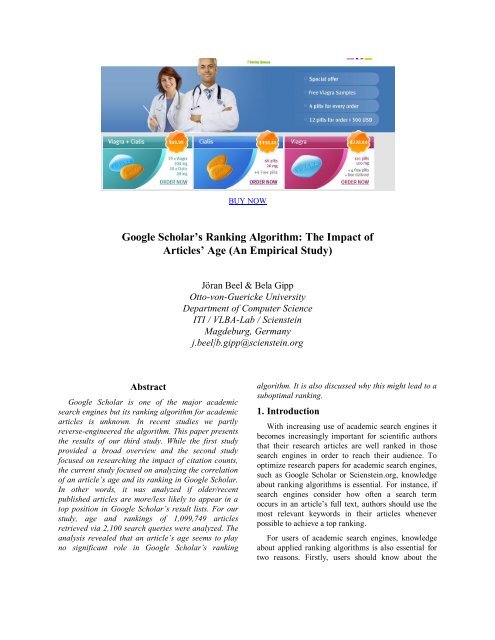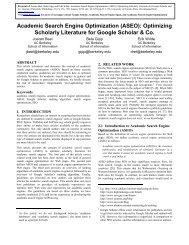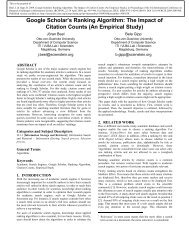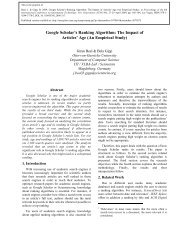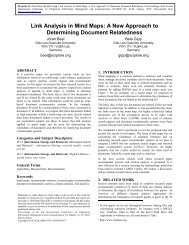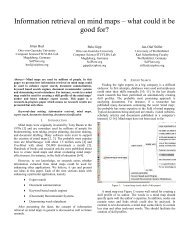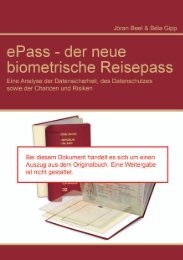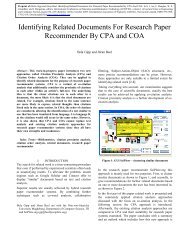Google Scholar's Ranking Algorithm: The Impact of ... - Jöran Beel
Google Scholar's Ranking Algorithm: The Impact of ... - Jöran Beel
Google Scholar's Ranking Algorithm: The Impact of ... - Jöran Beel
You also want an ePaper? Increase the reach of your titles
YUMPU automatically turns print PDFs into web optimized ePapers that Google loves.
BUY NOW<strong>Google</strong> Scholar’s <strong>Ranking</strong> <strong>Algorithm</strong>: <strong>The</strong> <strong>Impact</strong> <strong>of</strong>Articles’ Age (An Empirical Study)Jöran <strong>Beel</strong> & Bela GippOtto-von-Guericke UniversityDepartment <strong>of</strong> Computer ScienceITI / VLBA-Lab / SciensteinMagdeburg, Germanyj.beel|b.gipp@scienstein.orgAbstract<strong>Google</strong> Scholar is one <strong>of</strong> the major academicsearch engines but its ranking algorithm for academicarticles is unknown. In recent studies we partlyreverse-engineered the algorithm. This paper presentsthe results <strong>of</strong> our third study. While the first studyprovided a broad overview and the second studyfocused on researching the impact <strong>of</strong> citation counts,the current study focused on analyzing the correlation<strong>of</strong> an article’s age and its ranking in <strong>Google</strong> Scholar.In other words, it was analyzed if older/recentpublished articles are more/less likely to appear in atop position in <strong>Google</strong> Scholar’s result lists. For ourstudy, age and rankings <strong>of</strong> 1,099,749 articlesretrieved via 2,100 search queries were analyzed. <strong>The</strong>analysis revealed that an article’s age seems to playno significant role in <strong>Google</strong> Scholar’s rankingalgorithm. It is also discussed why this might lead to asuboptimal ranking.1. IntroductionWith increasing use <strong>of</strong> academic search engines itbecomes increasingly important for scientific authorsthat their research articles are well ranked in thosesearch engines in order to reach their audience. Tooptimize research papers for academic search engines,such as <strong>Google</strong> Scholar or Scienstein.org, knowledgeabout ranking algorithms is essential. For instance, ifsearch engines consider how <strong>of</strong>ten a search termoccurs in an article‟s full text, authors should use themost relevant keywords in their articles wheneverpossible to achieve a top ranking.For users <strong>of</strong> academic search engines, knowledgeabout applied ranking algorithms is also essential fortwo reasons. Firstly, users should know about the
Citation Count (Ordinal)algorithms in order to estimate the search engine‟srobustness to manipulation attempts by authors andspammers and therefore the trustworthiness <strong>of</strong> theresults. Secondly, knowledge <strong>of</strong> ranking algorithmsenables researchers to estimate the usefulness <strong>of</strong>results in respect to their search intention. Forinstance, researchers interested in the latest trendsshould use a search engine putting high weight on thepublications‟ date. Users searching for standardliterature should choose a search engine putting highweight on citation counts. In contrast, if a usersearches for articles from authors advancing a viewdifferent from the majority, search engines puttinghigh weight on citation counts might not beappropriate. googlexxxfods<strong>The</strong>refore, this paper deals with the question <strong>of</strong>how <strong>Google</strong> Scholar ranks its results. <strong>The</strong> paper isstructured as follows. In the second section relatedwork about <strong>Google</strong> Scholar‟s ranking algorithm ispresented. <strong>The</strong> third section covers the researchobjectives while the fourth section explains theutilized methodology. Finally, the results and theirinterpretation follow.2. Related WorkDue to different user needs, many academicdatabases and search engines enable the user to choosea ranking algorithm. For instance, ScienceDirect letsusers select between date and relevance 1 , IEEE Xplore<strong>of</strong>fers in addition a ranking by title and ACM DigitalLibrary allows users to choose whether to sort resultsby relevance, publication date, alphabetically by titleor journal, citation counts or downloads. However,these „algorithms‟ can be considered trivial since userscan select only one ranking criteria and are notallowed to use a (weighed) combination <strong>of</strong> them.1 „Relevance‟ in most cases means that the more <strong>of</strong>ten asearch term occurs in a document, the more relevant it isconsidered.1201008060402000 250 500 750 1000Position in <strong>Google</strong> ScholarFigure 1: Mean Citation Count<strong>Google</strong> Scholar is one <strong>of</strong> the few academic searchengines combining several approaches in a singlealgorithm 2 . Several studies about <strong>Google</strong> Scholarexist. For instance, about data overlap with otheracademic search engines such as Scopus and Web <strong>of</strong>Science [1], [2], <strong>Google</strong> Scholar‟s coverage <strong>of</strong> theliterature in general and in certain research fields[3], [4], the suitability to use <strong>Google</strong> Scholar‟s citationcounts googlexxx99gs for calculating bibliometric indices such as theh-indexgooglexxx99654r[5] and the reliability <strong>of</strong> <strong>Google</strong> Scholar as aserious information source in general [6], [7]. <strong>Google</strong>Scholar googlexxx645g itself publishes only vague information aboutits ranking algorithm: <strong>Google</strong> Scholar sorts “articlesthe way researchers do, weighing the full text <strong>of</strong> eacharticle, the author, the publication in which the articleappears, and how <strong>of</strong>ten the piece has been cited inother scholarly literature” [8]. Any other details orfurther explanation is not available.Although <strong>Google</strong> Scholar‟s ranking algorithm hasa significant influence on which academic articles areread by the scientific community, we could not findany studies about <strong>Google</strong> Scholar‟s ranking algorithmdespite our own ones [9], [10]. From our previousstudies we know that<strong>Google</strong> Scholar‟s ranking algorithm putshigh weight on words in the title.<strong>Google</strong> Scholar considers only those wordsthat are directly included in an article anddoes not consider synonyms <strong>of</strong> those words.<strong>Google</strong> Scholar seems to put no or low weighton the frequency with which search termsoccur in the full text. That means an article2 Others are, for instance, CiteSeer and Scienstein.org [11,12]
Yeargooglexxx9131, googlexxx9132, googlexxx9133,googlexxx9134, googlexxx9135, googlexxx9136,googlexxx9137, googlexxx9138will not be ranked higher for a certain searchjust because the search term occurs frequentlyin the full text. <strong>Google</strong> Scholar is not indexing textembedded via pictures. <strong>Google</strong> Scholar uses different rankingalgorithms for a keyword search in the fulltext, keyword search in the title, the „relatedarticles‟ function and the „cited by‟ function.2004200220001998199619941992199019881986<strong>Google</strong> Scholar‟s ranking algorithm putshigh weight on author and journal names.<strong>Google</strong> Scholar‟s ranking algorithm weighsheavily on articles‟ citation counts (seeFigure 1), whereas different patterns werediscovered.Mean0 250 500 750 1000Position in Result ListFigure 2: Mean Publication Year per PositionSince citation counts have a strong impact on<strong>Google</strong> Scholar‟s rankings, one could assume thatolder articles are found more <strong>of</strong>ten in top positions,since older publications naturally have had more timeto be cited. As a consequence, this practice wouldstrengthen the Matthew Effect 3 . To counteract theMatthew Effect and since one might assume that mostresearchers have an interest in the most recentresearch results rather than old ones, it seemsplausible to rank recent articles better than older ones.Our previous research indicated that publicationsfrom all years are approximately evenly distributedthroughout <strong>Google</strong> Scholars‟ result list (see Figure 2).3 <strong>The</strong> Matthew Effect describes that well known authors aremore <strong>of</strong>ten cited just because they are well known [13].Related to search engines this means: Articles with manycitations will be more likely displayed in top positions,therefore get more readers and receive more citations,which then consolidate their lead over lesser cited articles.<strong>The</strong>refore we concluded that an article‟s age plays asignificant role in <strong>Google</strong> Scholar‟s rankingalgorithm. However, the sample size was small, s<strong>of</strong>urther research was needed to confirm or reject thisfirst conclusion.3. Research Objective<strong>The</strong> research objective <strong>of</strong> the current study was toanalyze whether <strong>Google</strong> Scholar considers articles‟age in its ranking algorithm and if so to what extent.Since <strong>Google</strong> Scholar <strong>of</strong>fers two search modes(search in title and search in full text) and ourprevious study indicated that both search modes applydifferent ranking algorithms we also researchedwhether <strong>Google</strong> Scholar‟s different rankingalgorithms weigh differently on an articles‟ age.4. Methodology<strong>Google</strong> Scholar displays for most articles theirpublication year in the result list. To obtainpublication years for a significant number <strong>of</strong> papers,we developed a Java program to parse <strong>Google</strong> Scholar.This program sends search queries to <strong>Google</strong> Scholarand stores publication years and positions <strong>of</strong> allreturned results in a .csv file. Due to <strong>Google</strong> Scholar‟slimitations, only a maximum <strong>of</strong> 1,000 results persearch query was retrievable. <strong>The</strong> parsing process wasperformed twice, each time with 1,050 search querieswhereas the 1,050 search queries consisted <strong>of</strong> 350single-word search queries, 350 double-word searchExamplequeriesVectorandgraphic350 triple-wordxxx:search queries 4 . In thefirst run, search terms were searched in the full text.In the second run, search terms were searched in thetitle.Table 1: Amount <strong>of</strong> Search Results by Number <strong>of</strong> SearchTerms (Full Text Search)SingleTermsDoubleTermTripleTermTotalNumber <strong>of</strong> Search Results[0,1] [2, 10] [11, 50] [51, 250] [251, 1000] [1001, 10000] [10001, *] TotalAbsolute 0 0 0 0 0 2 348 350Relative 0,0% 0,0% 0,0% 0,0% 0,0% 0,6% 99,4% 100%Absolute 0 0 0 0 3 24 323 350Relative 0,0% 0,0% 0,0% 0,0% 0,9% 6,9% 92,3% 100%Absolute 0 0 0 1 4 86 259 350Relative 0,0% 0,0% 0,0% 0,3% 1,1% 24,6% 74,0% 100%Absolute 0 0 0 1 7 112 930 1050Relative 0,0% 0,0% 0,0% 0,1% 0,7% 10,7% 88,6% 100%From 1,050 full text searches, all search queriesreturned two or more results (see Table 1) and couldbe used for the analysis. From 1,050 title searches, 511returned either a zero or one result and were notconsidered for further analysis (see Table 2). This was4 <strong>The</strong> words for creating the search queries were extractedfrom an academic word list [14]
Publication YearPublication Yearcaused by the way search queries were created. <strong>The</strong>ywere created automatically by combining differentwords from a word list which resulted in somesenseless search queries such as „finish father‟ or„excessive royalty‟. While sufficient documentationexists in which, for instance, the words „finish‟ and„father‟ occur somewhere in the full text, nodocuments exist which include these words in the title.Table 2: Amount <strong>of</strong> Search Results by Number <strong>of</strong> SearchTerms (Title Search)SingleTermsDoubleTermTripleTermTotalNumber <strong>of</strong> Search Results[0,1] [2, 10] [11, 50] [51, 250] [251, 1000] [1001, 10000] [10001, *] TotalAbsolute 0 1 1 12 23 102 211 350Relative 0,0% 0,3% 0,3% 3,4% 6,6% 29,1% 60,3% 100%Absolute 166 89 54 27 11 3 0 350Relative 47,4% 25,4% 15,4% 7,7% 3,1% 0,9% 0,0% 100%Absolute 345 5 0 0 0 0 0 350Relative 98,6% 1,4% 0,0% 0,0% 0,0% 0,0% 0,0% 100%Absolute 511 95 55 39 34 105 211 1050Relative 48,7% 9,0% 5,2% 3,7% 3,2% 10,0% 20,1% 100%Overall, data from 1,561 search queries (1,050searches in the full text and 511 searches in the title)was used for further analysis. <strong>The</strong> 1,561 searchqueries returned a total <strong>of</strong> 1,364,757 results(1,032,766 articles for full text searches and 331,991articles for title searches). For 810,793 <strong>of</strong> the1,032,766 articles retrieved via full-text search and288,956 <strong>of</strong> the 331,991 articles retrieved via titlesearch, <strong>Google</strong> Scholar displayed the publication year.Those years and the articles' rankings were stored andanalyzed. To verify correct execution <strong>of</strong> the <strong>Google</strong>Scholar parser, spot checks were performed.All results <strong>of</strong> the search queries were visualized asgraphs to recognize patterns. In addition, the mean,median, and modal <strong>of</strong> each position was calculatedand displayed in a graph. Overall, a total <strong>of</strong> 1,567graphs were created and inspected individually.5. ResultsOn first glance, results <strong>of</strong> the current study seem toconfirm our previous results. Graphs <strong>of</strong> individualsearch queries show no significant interdependencybetween an article‟s age and its ranking in <strong>Google</strong>Scholar (see also [10]). This is true for all kind <strong>of</strong>search queries such as searches in full-text or title andsearches with single-word, double-word and triplewordqueries. <strong>The</strong> graphs show that publications fromall years are evenly distributed throughout the resultlist (see Figure 3, Figure 4 and Figure 5) 5 .5 <strong>The</strong> graphs also show that <strong>Google</strong> Scholar has far moredocuments from the 90s and current decade in its databasethan from decades before. However, this is out <strong>of</strong> thecurrent study‟s scope.However, looking at the average age, anotherimpression evolves. Figure 6 displays the averagepublication year (mean) for each position in <strong>Google</strong>Scholar. It shows clearly that in the top positionsarticles are on average older than articles in theremaining positions 6 .A look at the numbers confirms this assumption.While those papers ranked in position 1 by <strong>Google</strong>Scholar were on average published in 1992, papers onposition 5 were on average published in 1993, paperson position 100 in 1994 and papers on position 500 in1995 (see Table 3). Graphs for title-searches looksimilar (see Figure 7) and no significant differencesoccurred between single-word, double word and tripleword search queries 7 .20082003199819931988198319781973196819631958200820031998199319881983197819731968196319580 200 400 600 800 1000Position in <strong>Google</strong> ScholarFigure 3: Search Query 'Future'0 200 400 600 800 1000Position in <strong>Google</strong> ScholarFigure 4: Search Query '<strong>Google</strong> Scholar'6 Graphs for the modal and median publication year showsimilar pictures.7 In all graphs, some outliers can be observed in the very lastpositions. This is due to <strong>Google</strong> Scholar which <strong>of</strong>ten doesnot return the very last results. <strong>The</strong>refore the means forthe last positions was based on few sample data and hencesome outliers could spoil the results.
Publication YearPublication YearPublication Year20082003199819931988198319781973196819630 200 400 600 800 1000Position in <strong>Google</strong> ScholarFigure 5: Search Query 'Climate Change Discussion'1997199619951994199319921991199019890 200 400 600 800 1000Position in <strong>Google</strong> ScholarFigure 6: Mean Publication Year (Full-Text Search)Table 3: Mean Publication Year (Selected Positions)PositionPublicationYear (Mean) PositionPublicationYear (Mean)1 1992 10 19942 1992 50 19943 1992 100 19944 1993 250 19945 1993 500 1995199619951994199319921991199019890 200 400 600 800 1000Position in <strong>Google</strong> ScholarFigure 7: Mean Publication Year (Title Search)6. Interpretation and DiscussionTaking into consideration that <strong>Google</strong> Scholarmight become as popular for academic articles as<strong>Google</strong> is for web pages, we hope to stimulate adiscussion with our research into how rankingalgorithms <strong>of</strong> academic search engines should bedesigned. We believe that users should be able toadjust ranking algorithms to their individual searchintension (search for standard literature, search forlatest research trends, search for articles by authorsadvancing a view different from the mainstream, etc.).If a search engine does not <strong>of</strong>fer this option, as isthe case with <strong>Google</strong> Scholar, users should at leasthave basic knowledge about the applied rankingalgorithm. Only this way they can assess the suitability<strong>of</strong> an academic search engine for their searchintension.Our research shows that in <strong>Google</strong> Scholar olderarticles are found more <strong>of</strong>ten in top positions thanrecent articles. This is probably due to <strong>Google</strong>Scholar‟s strong focus on citation counts and due to<strong>Google</strong> Scholar putting no or low weight on anarticle‟s publication date. As a consequence, <strong>Google</strong>Scholar is rather suitable for finding standardliterature than the latest research results.7. Further Research & Data SharingThis is our third paper about <strong>Google</strong> Scholar‟sranking algorithm and the algorithm is still far frombeing known. We invite researchers to join us andwould be happy to share our <strong>Google</strong> Scholar parserand gathered data. Please send us an email if you areinterested in the data or s<strong>of</strong>tware.8. AcknowledgementsOur thanks go to Ammar Shaker for supporting thedevelopment <strong>of</strong> the <strong>Google</strong> Scholar parser.9. References[1] J. Bailey, C. Zhang, D. Budgen, M. Turner, andS. Charters, “Search engine overlaps : Do they agree ordisagree?” in Second International Workshop on RealisingEvidence-Based S<strong>of</strong>tware Engineering (REBSE '07), 2007,p. 2. [Online]. Available:http://ieeexplore.ieee.org/xpls/abs_all.jsp?arnumber=4273274[2] K. Yang and L. I. Meho, “Citation analysis: Acomparison <strong>of</strong> google scholar, scopus, and web <strong>of</strong> science,”in 69th Annual Meeting <strong>of</strong> the American Society forInformation Science and Technology, Austin (US), 2006,pp. 3–8.
[3] W. H. Walters, “<strong>Google</strong> scholar coverage <strong>of</strong> amultidisciplinary field,” Information Processing &Management, vol. 43, no. 4, pp. 1121–1132, July 2007.[4] J. J. Meier and T. W. Conkling, “<strong>Google</strong> scholar‟scoverage <strong>of</strong> the engineering literature: An empirical study,”<strong>The</strong> Journal <strong>of</strong> Academic Librarianship, vol. 34, no. 34, pp.196–201, 2008.[5] J. Bar-Ilan, “Which h-index? - a comparison <strong>of</strong> wos,scopus and google scholar,” Scientometrics, vol. 74, no. 2,pp. 257–271, 2007.[6] P. Jacso, “<strong>Google</strong> scholar: the pros and the cons,” OnlineInformation Review, vol. 29, no. 2, pp. 208–214, 2005.[7] B. White, “Examining the claims <strong>of</strong> google scholar as aserious information source,” New Zealand Library &Information Management Journal, vol. 50, no. 1, pp. 11–24,2006.[8] (2008) About google scholar. Website. <strong>Google</strong> Inc.[Online].Available:http://scholar.google.com/intl/en/scholar/about.html[9] J. <strong>Beel</strong> and B. Gipp, “<strong>Google</strong> scholar's rankingalgorithm: An introductive overview (research in progress),”in Proceedings <strong>of</strong> 3rd International Conference on ResearchChallenges in Information Science (RCIS’09). IEEE, 2009.[10] J. <strong>Beel</strong> and B. Gipp, “<strong>Google</strong> scholar's rankingalgorithm: <strong>The</strong> impact <strong>of</strong> citation counts (an empiricalstudy).” to be published, 2009.[11] B. Gipp and J. <strong>Beel</strong>, “Scienstein: A research paperrecommender system,” in International Conference onEmerging Trends in Computing. IEEE, 2009, pp. 309–315.[12] J. <strong>Beel</strong> and B. Gipp, “<strong>The</strong> potential <strong>of</strong> collaborativedocument evaluation for science,” in 11th InternationalConference on Digital Asian Libraries (ICADL'08), ser.Lecture Notes in Computer Science (LNCS), G. Buchanan,M. Masoodian, and S. J. Cunningham, Eds., vol. 5362.Heidelberg (Germany): Springer, December 2008, pp. 375–378.[13] R. K. Merton, “<strong>The</strong> matthew effect in science,”Science, vol. 159, no. 3810, pp. 56–63, January 1968.[14] S. Haywood. (2008) <strong>The</strong> academic word list. University<strong>of</strong> Nottingham. [Online]. Available:http://www.nottingham.ac.uk/ alzsh3/acvocab/wordlists.htm


